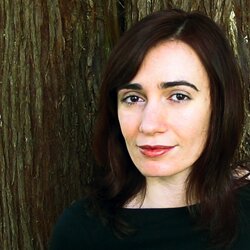On Tuesday night, two grand pianos, a miniature set of clock chimes, and a whimsical toy piano shared the expansive stage at the University of Washington’s Meany Hall. This unusual collection of instruments was brought together by local pianist Cristina Valdes to demonstrate the many ways composers create music for the piano. Her program, “The 21st Century Piano,” presented five contemporary works, including world premieres by local composers Richard Karpen and Huck Hodge.

Known as a champion of contemporary music, Valdes has toured nationally as part of the Bang on a Can All Stars, a touring ensemble devoted to performing new works by living composers. Here in Seattle, she serves on the piano faculty at Cornish College of the Arts and produces the Seattle Latin American Music (SLAM) Festival. Valdes maintains a busy performance schedule around the city. Earlier this month, she joined members of the Seattle Symphony for a performance of Schoenberg’s Pierrot Lunaire.
According to Valdes, today’s composers have turned to sound as the driving force in their writing, “using the compositional process as a means to produce sound.” All five pieces on Tuesday night’s program illustrated efforts to experiment with new ways to produce noises on the piano and expand the instrument’s sonic palette. As in any typical piano recital, technical virtuosity and emotional expression were certainly on display.
However, this concert showcased a wider spectrum of Valdes’ talents as a performer, sending the pianist on a tour of her instrument — reaching inside the case to pluck the strings, creating sheets of sound by slamming her forearm on the keys, and playing alongside pre-recorded piano sounds.
Jonathan Harvey’s Tombeau de Messiaen, a work for piano and CD, had Valdes accompanying a recording of a piano tuned to the harmonic series. The live and recorded piano parts chase and echo each other, sometimes overlapping so much that it’s difficult to distinguish between the two. At the work’s frenetic finale, the tones produced by Valdes’ flying fingers blurred with the recorded sounds, creating an in-your-face cloud of noise that sounded like hundreds of pinballs bouncing on the piano strings.
Nathan Davis’ The Mechanics of Escapement received its West Coast premiere at Tuesday’s concert. Written for toy piano and clock chimes, the piece requires the performer to play both instruments at once, accompanying clicks and taps on the toy piano with the occasional authoritative toll from the clock chime. Although both toy piano and clock chimes are whimsical in appearance, the music is far from droll. Davis’ writing emphasizes the percussive nature of the instruments, with some sections resembling the sounds produced by an Indonesian gamelan or a piano prepared by John Cage. One part even had Valdes scraping a violin bow across the chimes.
Works for unaccompanied piano played a large role in the concert as well. Although this format is far more traditional than Harvey and Davis’ experimental instrumentation, the program’s two solo piano offerings pushed boundaries in other ways. Seattle-based composer Huck Hodge’s Transfigured Etudes blends distinctive stylistic elements of other composers (Chopin, Couperin, Liszt, Nancarrow, and others) with a decidedly contemporary twist. The first of the five études was particularly effective, capturing the storm and fire of Chopin’s Revolutionary Etude — but with twists in melody and harmony. In contrast, Tristan Murail’s eerie La Mandragore (“The Mandrake”) showcased Valdes’ ability to create a mood of mystery. The sonorous piece relies on repeated notes and chiming harmonies high on the piano to evoke a spooky night-time landscape.
UW School of Music Director Richard Karpen joined Valdes onstage for the final work on the program, Karpen’s A Little Music for two pianos. Performed without a score, the piece seems to be a scripted improvisation, in which the pianists move through a pre-determined set of musical topics in a specific order. Some sections had Karpen and Valdes playing in unison or echoing each other, while others were so full of contrast that the pianists almost seemed to be unaware of each other’s existence.
The work is a mixed bag, jumping from idea to idea. The piece begins with the two performers emphatically pecking out single notes in unison. Eventually, this builds and flows into a lengthy quote from a Chopin Nocturne, which in turn evolves into a storm cloud of low, rumbling tremolos. At times, the transitions are tricky to follow, but it’s worth hanging on for the ride — the sheer diversity of sounds created throughout the piece is mesmerizing.
If Valdes’ survey of the contemporary piano is any indication, the future looks bright for the instrument. Based on Tuesday night’s program, her vision of the 21st century piano is engaging and appealing, full of creative new repertoire that stretches audiences instead of alienating them. We’re lucky to have Valdes as a mover and shaker in the local scene, serving as an ambassador for new voices and sounds in today’s musical landscape.
Missed Tuesday’s performance? Catch Cristina Valdes (and a host of other local classical music luminaries) tonight at a Classical House Show produced by the Table & Chairs record label.